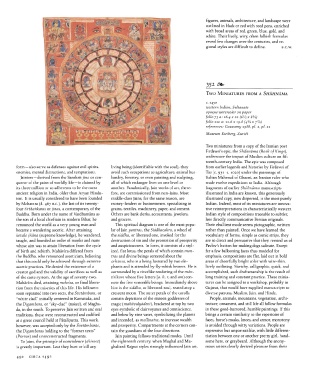Page 493 - Art In The Age Of Exploration (Great Section on Chinese Art Ming Dynasty)
P. 493
figures, animals, architecture, and landscape were
outlined in black or red with reed pens, enriched
with broad areas of red, green, blue, gold, and
white. Their lively, wiry, often folkish formulas
reveal few changes over the centuries, and re-
gional styles are difficult to define. s.c.w.
352
Two MINIATURES FROM A SHAHNAMA
c. 1450
western Indian, Sultanate
opaque watercolor on paper
5
folio 73 a: 16.4 x 22 (6/2 x 8 /s)
l
7
folio 112 a: 11.6 x 19.8 (4% x y /s)
references: Goswamy 1988, pi. 2, pi. 11
Museum Rietberg, Zurich
Two miniatures from a copy of the Iranian poet
Firdawsi's epic, the Shdhndma (Book of Kings),
underscore the impact of Muslim culture on fif-
teenth-century India. The epic was composed
form — also serve as defenses against evil spirits, living being (identifiable with the soul), they from earlier legends and histories by Firdawsi of
enemies, mental distractions, and temptations. avoid such occupations as agriculture, animal hus- Tus (c. 931-c. 1020) under the patronage of
Jainism —derived from the Sanskrit jina or con- bandry, forestry, or even painting and sculpting, Sultan Mahmud of Ghazni, an Iranian ruler who
queror of the pains of worldly life — is claimed by all of which endanger lives on one level or made twelve expeditions to India. Although
its three million or so adherents to be the most another. Paradoxically, Jain works of art, there- fragments of earlier Shdhndma manuscripts
ancient religion in India, older than Aryan Hindu- fore, are commissioned from non-Jains. Most illustrated in India are known, this generously
ism. It is usually considered to have been founded middle-class Jains, for the same reason, are illustrated copy, now dispersed, is the most purely
by Mahavira (d. 467 B.C.), the last of its twenty- money-lenders or businessmen, specializing in Indian. Indeed, most of its miniatures are innova-
four tirthahkaras or jinas, a contemporary of the grains, textiles, machinery, paper, and cement. tive reinterpretations in characteristically western
Buddha. Born under the name of Vardhamana as Others are bank clerks, accountants, jewelers, Indian style of compositions traceable to subtler,
the son of a local chieftain in modern Bihar, he and grocers. less directly communicative Persian originals.
renounced the world as a very young man and This spiritual diagram is one of the most popu- Their ebullient mode seems pictographic, written
became a wandering ascetic. After attaining lar of Jain yantras, the Siddhacakra, a wheel of rather than painted. Once we have learned the
kevala jnana (supreme knowledge), he wandered, the siddha, or liberated one, invoked for the vocabulary of forms, simple as comic strips, they
taught, and founded an order of monks and nuns destruction of sin and the promotion of prosperity are so direct and persuasive that they remind us of
whose aim was to attain liberation from the cycle and auspiciousness. In form, it consists of a styl- Pavlov's button for making dogs salivate. Except
of birth and rebirth. Mahavira differed from ized, flat lotus, the petals of which contain man- for a few ballooning faces thus modeled for
the Buddha, who renounced asceticism, believing tras and divine beings centered about the emphasis, compositions are flat, laid out in bold
that this could only be achieved through extreme arhanta, who is a being lustrated by two ele- areas of cheerfully bright color with wire-thin,
ascetic practices. He denied the existence of a phants and is attended by fly-whisk bearers. He is lively outlining. Sketchy, calligraphic, quick, and
creator god and the validity of sacrifices as well as surrounded by a riverlike rendering of the mdn- accomplished, such draftsmanship is the result of
of the caste system. At the age of seventy-two, tirikam whose five letters [a, h, r, and am) con- long training and constant practice. These minia-
Mahavira died, attaining moksha, or final libera- note the five venerable beings. Immediately above tures can be assigned to a workshop, probably in
tion from the miseries of this life. His followers him is the siddha, or liberated soul, seated atop a Gujarat, that would have supplied manuscripts to
soon separated into two sects, the Svetdmbara, or crescent moon. The outer petals of the corolla diverse patrons, Muslim, Jain, and Hindu.
"white clad/' initially centered in Karnataka, and contain depictions of the sixteen goddesses of People, animals, mountains, vegetation, archi-
the Digambara, or "sky-clad" (naked), of Magha- magic (mahavidy ddevi) bracketed at top by two tecture, ornament, and still life all follow formulas
r
da, in the south. To preserve Jain written and oral eyes symbolic of clairvoyance and omniscience, in these good-humored, humble paintings. If this
traditions, these were reconstructed and codified and below by nine vases, symbolizing the planets brings a certain similarity to the repertoire of
at a great council held at Pataliputra. This work, and intended, as mallinatra, to increase wealth faces, horse's masks, knees, and armor, monotony
however, was accepted only by the Svetambaras, and prosperity. Compartments at the corners con- is avoided through witty variations. People are
the Digambaras holding to the "former texts" tain the guardians of the four directions. expressive but unportraitlike, with little differen-
(Purvas) and unreconstructed fragments. Jain painting follows traditional modes. Until tiation between one or another pretty girl, hand-
To Jains, the principle of nonviolence (ahimsd) the eighteenth century, when Mughal and Mu- some hero, or graybeard. Although the anony-
is greatly important. Lest they hurt or kill any ghalized Rajput styles strongly influenced Jain art, mous artists clearly derived pleasure from their
492 CIRCA 1492

